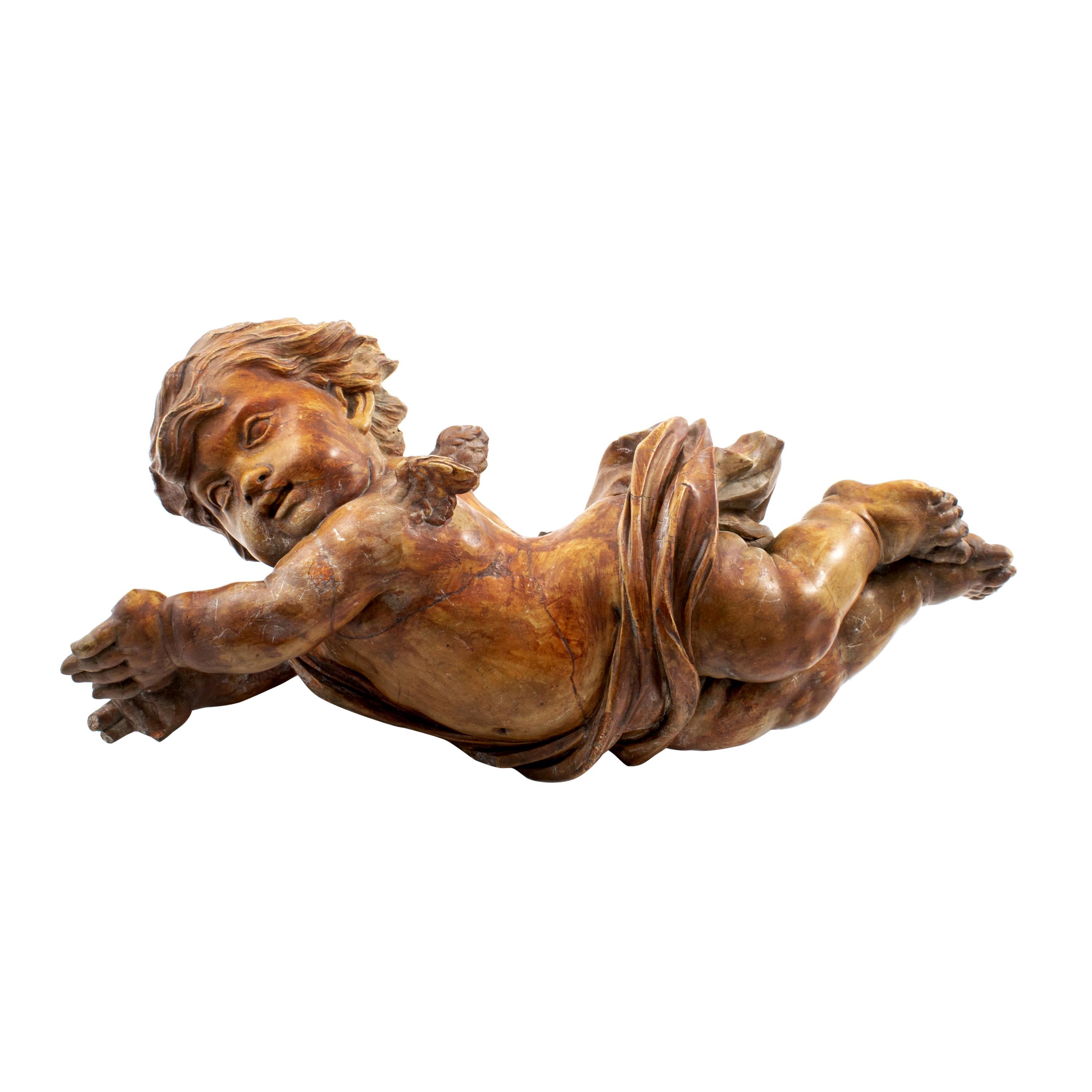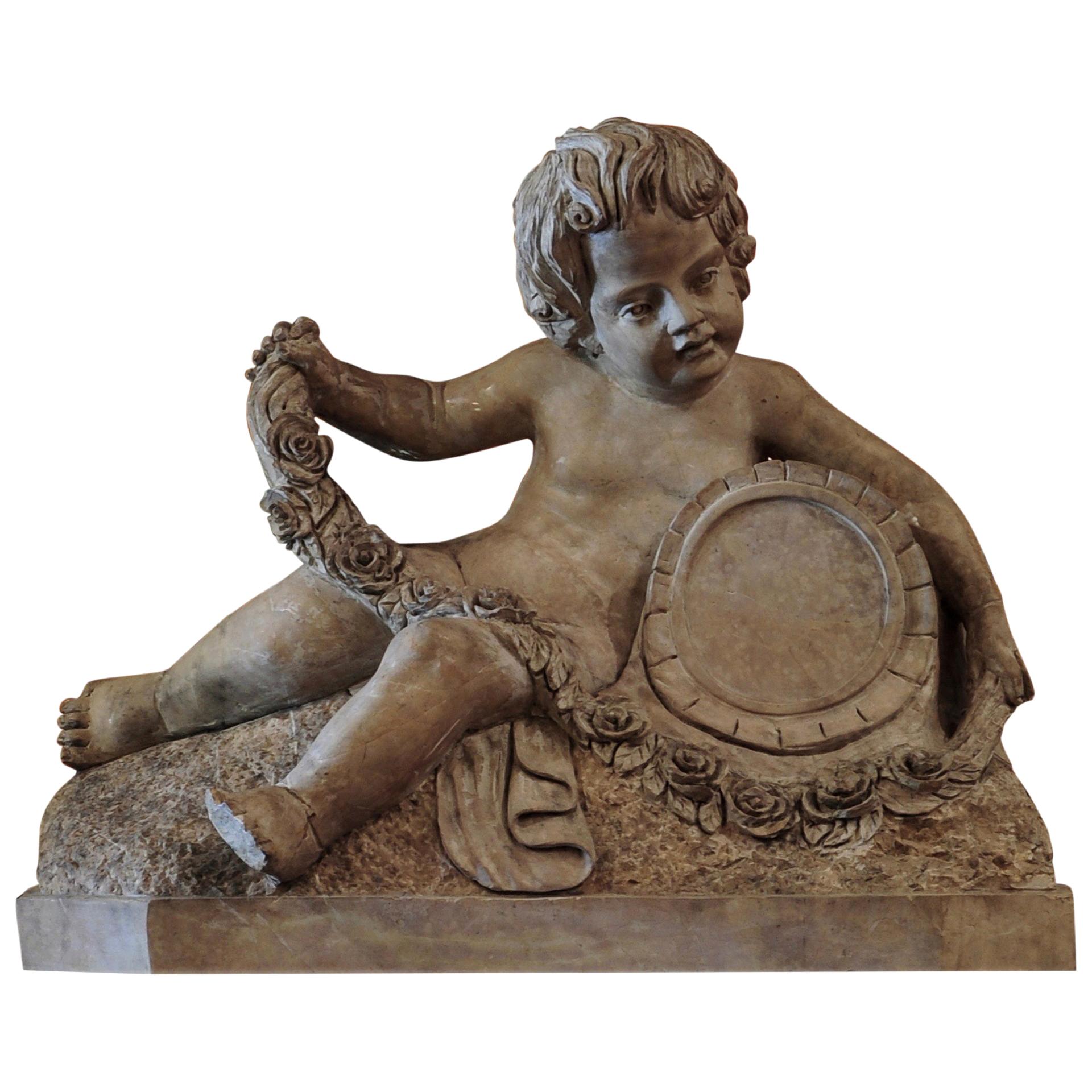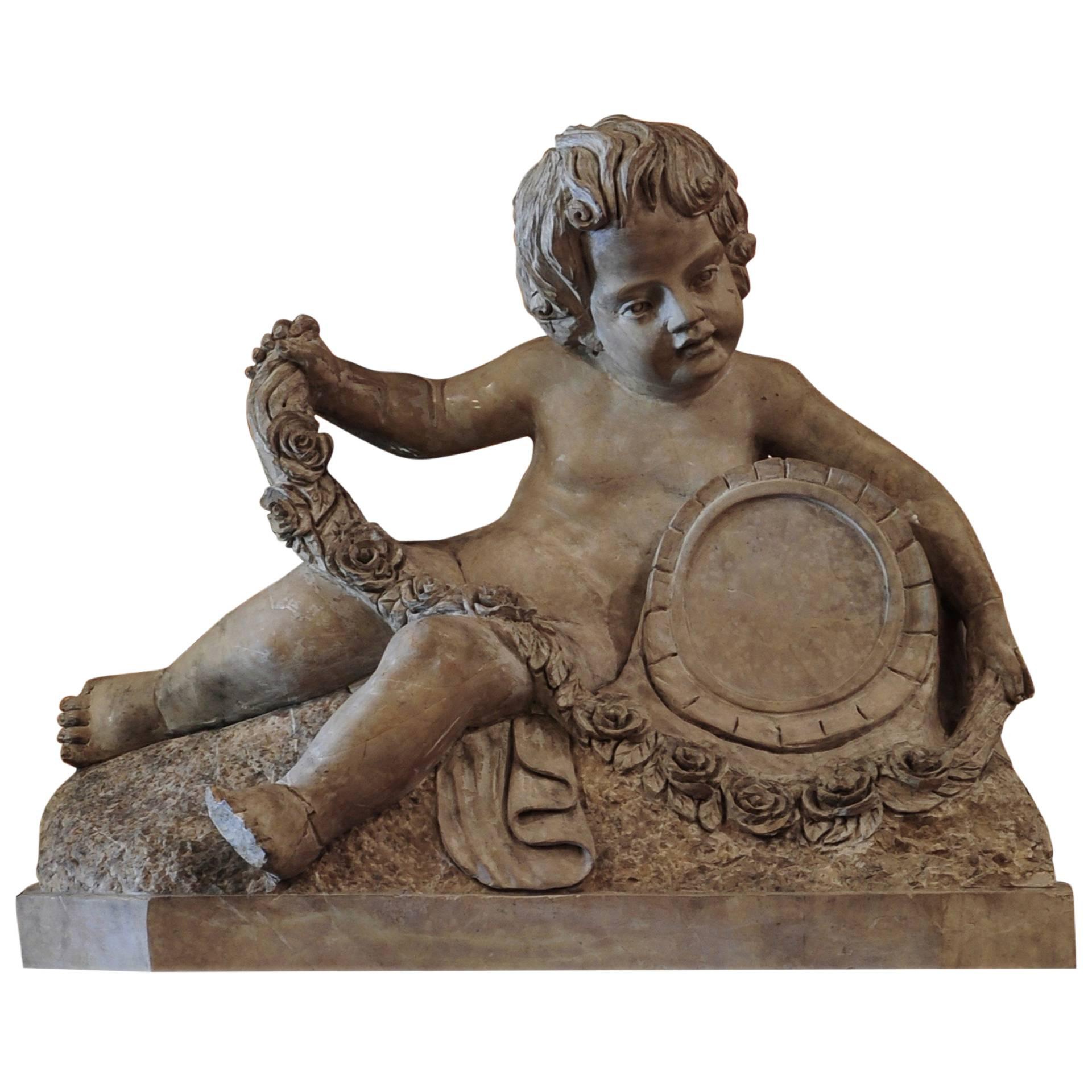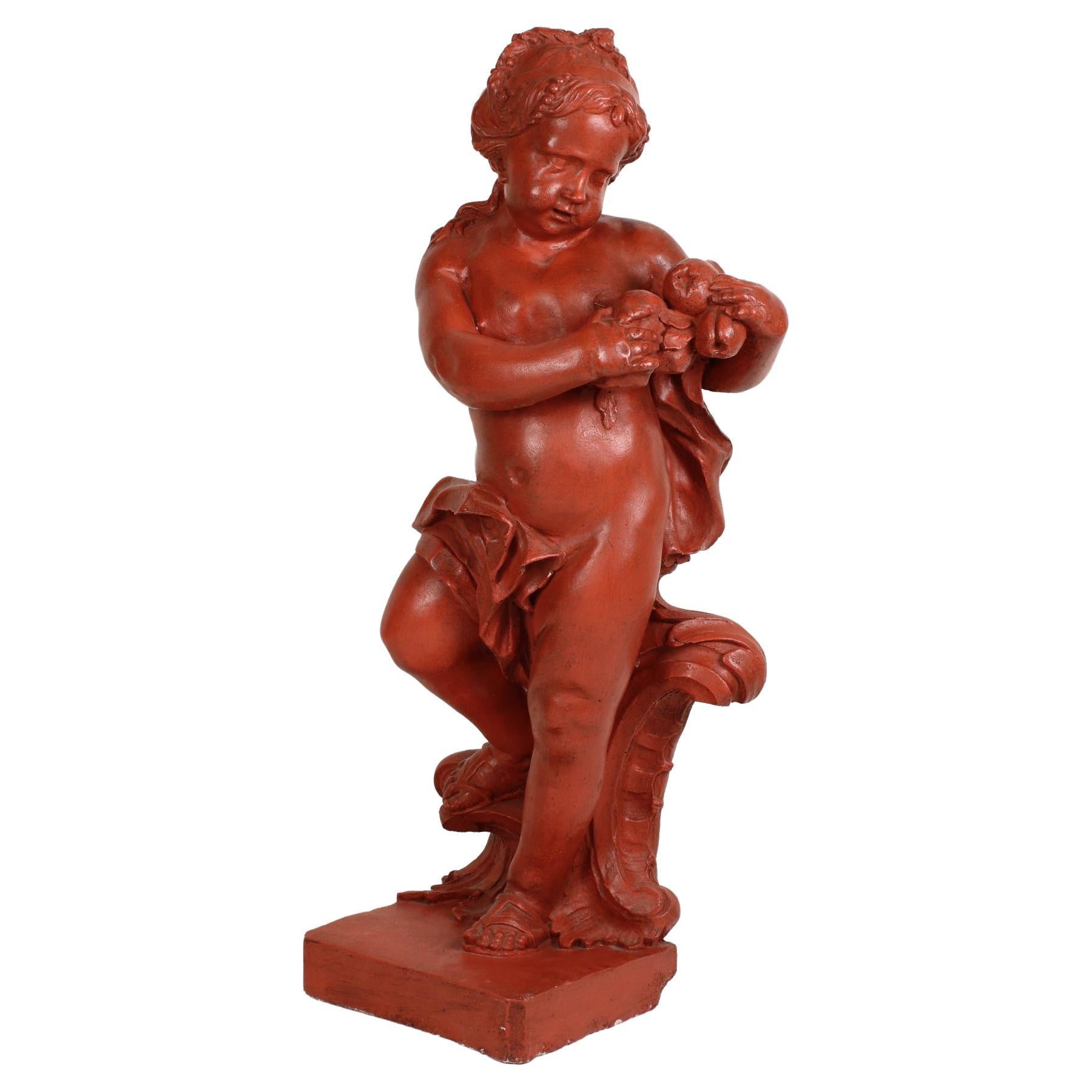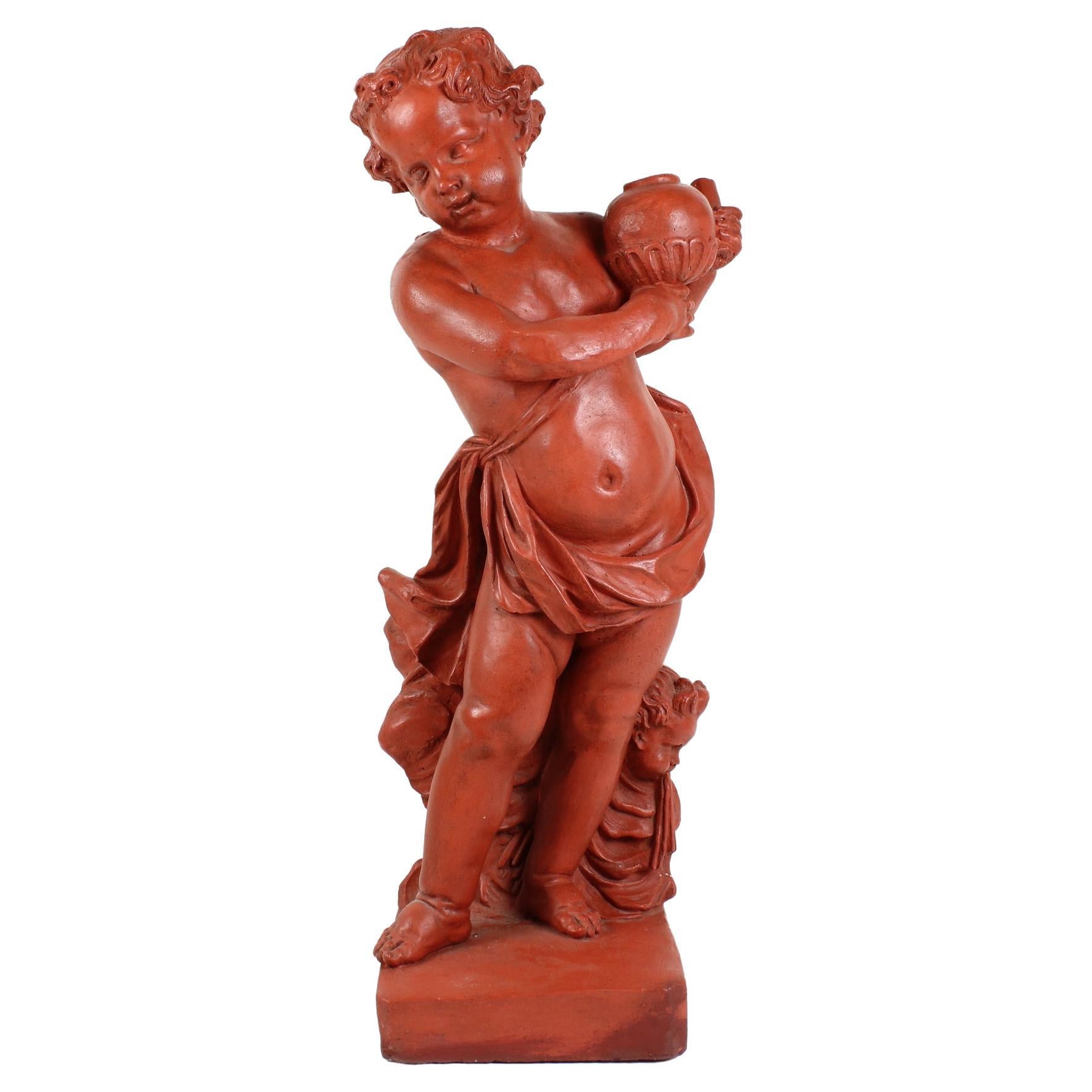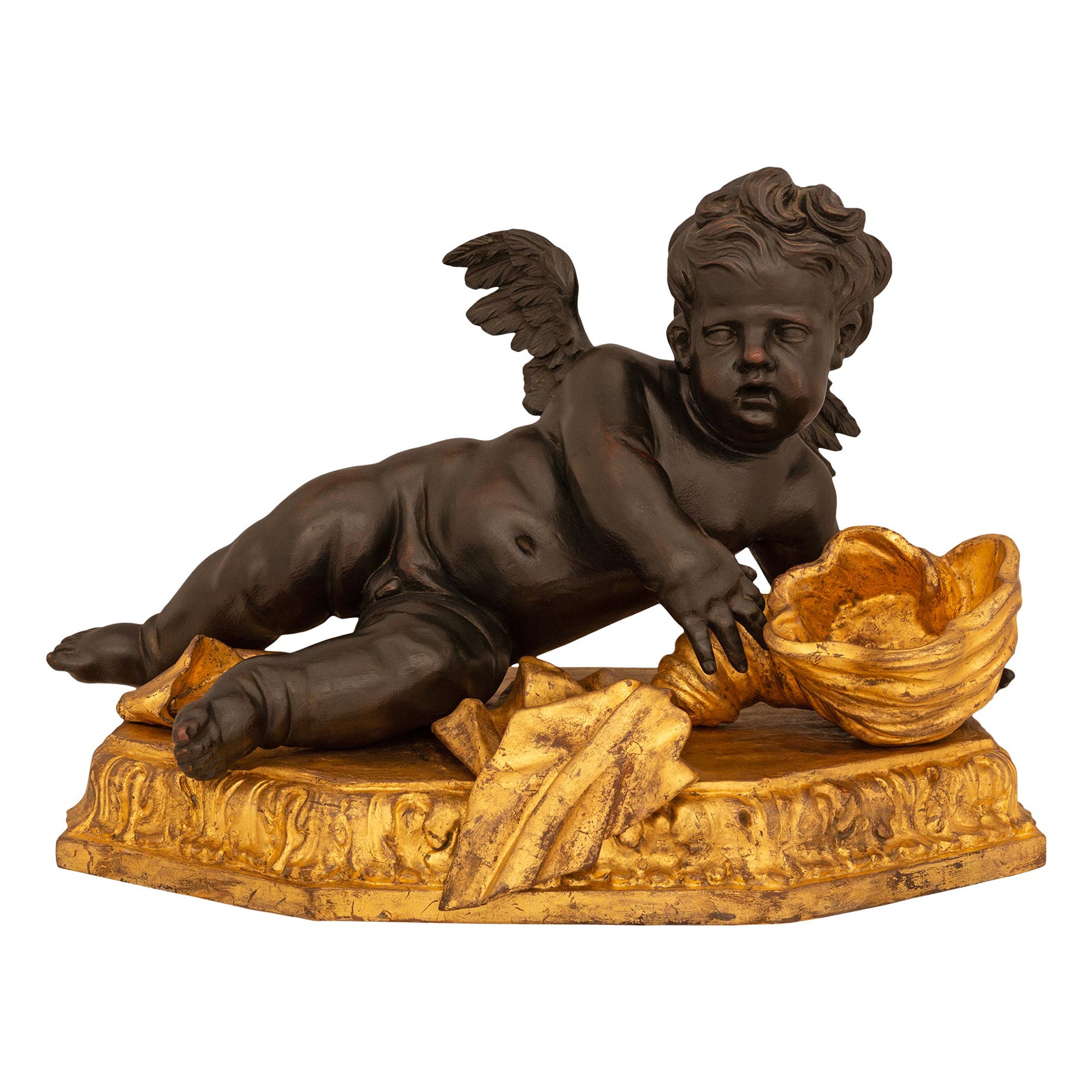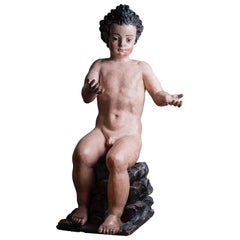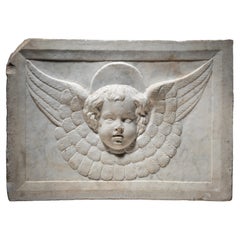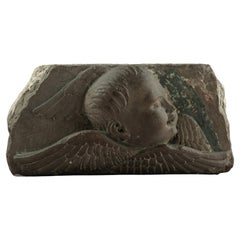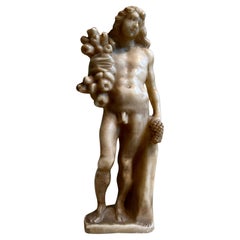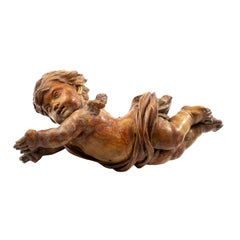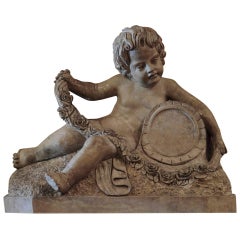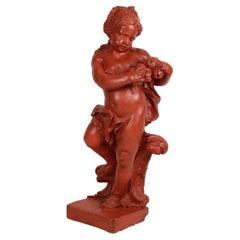Items Similar to Carlo Marcellini 'Florence 1644 – 1713', Florentine Baroque Putto
Want more images or videos?
Request additional images or videos from the seller
1 of 5
Carlo Marcellini 'Florence 1644 – 1713', Florentine Baroque Putto
$74,582.07
£54,728.99
€62,000
CA$101,392.61
A$113,572.75
CHF 59,045.21
MX$1,402,394.97
NOK 752,189.47
SEK 711,078.11
DKK 471,931.46
Shipping
Retrieving quote...The 1stDibs Promise:
Authenticity Guarantee,
Money-Back Guarantee,
24-Hour Cancellation
About the Item
Carlo Marcellini (Florence 1644 – 1713)
Putto
White and green marble
41.5 x 73.5 cm
This marble putto carved in high relief, almost a tutto tondo, and set on an elegant green marble background, appears almost naked, sitting on a cloud. His peculiar pose, in adoration, suggests that the work was a part of a larger composition including other figures in devotion.
Published in 2007 by Sandro Bellesi in the monograph dedicated to Gioacchino Fortini (pg.155), this beautiful marble putto was included in the catalog of Carlo Marcellini, a prominent figure in the baroque renewal of Florentine art.
Born in Florence in 1644, Carlo Marcellini received his artistic education in the city of the lily, specializing in stone sculpture and stucco modeling under the guidance of Bartolomeo Cennini before continuing his studies in Rome in the Accademia Medicea founded by the Grand Duke Cosimo III in order to familiarize some more promising artists with the essential “ taste of Rome ”.
Under the guidance of Ercole Ferrata and Ciro Ferri, Giovan Battista Foggini and Carlo Marcellini were able to study in the Urbe the masterpieces of the past, the major works of the Cinquecento as well as the latest artistic novelties in vogue in the eternal city.
As he came back to Florence in 1676, thanks to his fine artistic skills, he was asked to work for the most important Florentine families as well as to adorn the main religious buildings of the Tuscan capital.
He embarked upon a prolific career, often flanked by his fellow student, Foggini and obtained some prestigious commissions for the Grand Dukes of Tuscany and important aristocratic families, including the Corsini.
He died in Florence in 1713 after a long career of important public and private commissions.
The attribution to Carlo Marcellini's catalog of this putto is based on the comparison with a series of marble and bronze reliefs for the Church of Santa Maria De ’Pazzi in Florence. Carved between 1678 and 1685 under the direction of Cirro Ferri, these marble reliefs, framed in yellow Serravezza marble, shows angels supporting medallions with episodes dedicated to the life of Santa Maria Maddalena dei Pazzi.
Particularly close stylistically to our sculpture, the putto with the two angels supporting the medallion with Santa Maria dei Pazzi predicting the pontificate and the death of Cardinal Alessandro De 'Medici (see the “Repertorio della scultura fiorentina del Seicento e Settecento, a cura di G. Pratesi, Torino 1993, fig. 318).
This putto figure obliquely, with the face in short cut and shows obvious analogies with our putto not only for its pose but also for the particular morphology of its features, for the soft and almost tactile rendering of the skin and for the textile and vibrant effect of the drapery and the cloud, which play entirely on harmonious contrasts of light and shade.
The expertly carved work shows an "obvious Roman imprint" according to Bellesi who dates our putto between 1670 and 1680, in the years following the artist's repatriation to Florence after his training in the eternal city.
However, this sculpture result from such refined synergy between the seventeenth century Roman Baroque and fleeting reflections on Genoese artistic trends, successfully diffused by Filippo Parodi.
Bibliography :
- L. Arachi, P.Gentilini, La grotta di Palazzo Corsini a Firenze, dans Commentari d’arte, VI 2000, 15-17
- S . Bellesi, - M. Visonà, Giovacchino Fortini. Scultura, architettura, Decorazione e Committenza privata a Firenze al tempo degli ultimi Medici, Firenze, 2007, pg.155
- G. Pratesi, Repertorio della scultura fiorentina del Seicento e Settecento, II, Torino, 1993, fig. 318
- M. Visonà, Carlo Marcellini. Accademico “spiantato” nella cultura fiorentina tardo-barocca, Firenze 1990.
- M.Visonà, L’Accademia di Cosimo III, Roms 1673-1686, dans Storia delle Arti in Toscana. II, Elle, a cura di M.Gregori Pise 2001
- Dimensions:Height: 28.94 in (73.5 cm)Width: 16.34 in (41.5 cm)Depth: 6.7 in (17 cm)
- Style:Baroque (Of the Period)
- Materials and Techniques:
- Place of Origin:
- Period:
- Date of Manufacture:17th Century
- Condition:Repaired: One finger has been restored. Wear consistent with age and use.
- Seller Location:Bruxelles, BE
- Reference Number:1stDibs: LU6666234705472
About the Seller
5.0
Vetted Professional Seller
Every seller passes strict standards for authenticity and reliability
1stDibs seller since 2022
15 sales on 1stDibs
Typical response time: 2 hours
- ShippingRetrieving quote...Shipping from: Bruxelles, Belgium
- Return Policy
Authenticity Guarantee
In the unlikely event there’s an issue with an item’s authenticity, contact us within 1 year for a full refund. DetailsMoney-Back Guarantee
If your item is not as described, is damaged in transit, or does not arrive, contact us within 7 days for a full refund. Details24-Hour Cancellation
You have a 24-hour grace period in which to reconsider your purchase, with no questions asked.Vetted Professional Sellers
Our world-class sellers must adhere to strict standards for service and quality, maintaining the integrity of our listings.Price-Match Guarantee
If you find that a seller listed the same item for a lower price elsewhere, we’ll match it.Trusted Global Delivery
Our best-in-class carrier network provides specialized shipping options worldwide, including custom delivery.More From This Seller
View AllCercle of Juan Martinez Montañés '1568-1649', Infant St John the Baptist
Located in Bruxelles, BE
Cercle of Juan Martinez Montañés (1568-1649)
Infant St John the Baptist
Spanish, 17th century
H 74 cm
Saint John the Baptist is here represented naked, sitting on a rock, with...
Category
Antique 17th Century Spanish Renaissance Figurative Sculptures
Materials
Wood
Cercle of Jacopo della Pila - Marble relief depicting a winged Cherub
Located in Bruxelles, BE
Cercle of Jacopo della Pila (Lombard, in Naples 1471-1502)
Marble relief depicting a winged Cherub
Naples, second half of15th century
40 x 57 x 12 cm
Exquisitely carved, this relief portrays a winged cherub with cascading hair and delicate features. The cherub's plump, smooth countenance, rounded cheeks, outlined lips, and finely drawn nose emanate a sense of tenderness. The quadrangular module, is adorned with a carved frame. The relief ascends gradually, transitioning from the low relief of the wings to the high relief of the head.
The rectangular frame and the subtly curved form of the artwork suggest that the relief likely adorned the upper part of an arch or a vaulted chapel. The type is that of the perspective room with a coffered ceiling decorated with figures of winged cherubs, which is found in various Neapolitan chapels of the 15th century. Coffered ceilings attest to the recovery of antiquity and the search for luxury in Renaissance architecture, first in Florence, then in Rome and Naples. The majority of the numerous family chapels and tombs built during the late fifteenth century in south of Italy employ the new formal vocabulary of the Florentine Renaissance in a self-confident manner that permitted a broad spectrum of variations.
The escalating admiration for the classical world, coupled with the development of perspective, significantly contributed to the Renaissance endorsement of coffered ceilings. This artistic and constructive device drew inspiration from the intricate marble patterns observed in historical landmarks such as the Arch of Titus, the Temple of Vesta in Tivoli, the Pantheon, and the Basilica of Maxentius. A distilled product of both mathematical and artistic cultures, deeply scrutinizing the ancient world, the coffered ceiling plays a vital role in the perspective construction of space with its regular and directional geometry. The motif of the coffered ceiling decorated with cherubs in relief was introduced in Naples by Francesco Laurana in the plastic decoration of the Arch of Castelnuovo. Laurana's impact on the art scene in the south of Italy was profound. The introduction of the winged cherub into the region's artistic vocabulary bridged the gap between the classical and the contemporary, creating a synthesis that resonated with both aesthetic and spiritual sensibilities. His influence extended beyond the immediate visual appeal, shaping the cultural identity of the Renaissance in southern Italy. Although the plastic decoration of the Arch of Castelnuovo cannot certainly be ascribed to a mature Renaissance style, it was precisely on this occasion that the sculptors who worked there could get to know and export throughout the Italian peninsula that type of "Florentine classicism" which, even in the 15th century Naples, was conditioned by the Burgundian culture imported into the Kingdom by Alfonso of Aragon himself, with artists called from Spain and Northern Europe. The coffered ceiling, with its geometric patterns and Laurana's winged cherubs nestled within, became a symbol of refinement and cultural sophistication. The relief sculptures, carefully integrated into the overall design, transformed the ceiling into a celestial realm, inviting viewers to contemplate the divine while immersed in the grandeur of the Renaissance space.
Similar winged cherubs appears also in the Naples cathedral. Within the renowned Succorpo Chapel, a mesmerizing marble coffered ceiling adorned with cherubs epitomizes the splendor of the Neapolitan Renaissance. The interplay of light and shadow on the textured surface of the marble coffered ceiling introduces an ethereal dimension, providing an immersive visual experience for observers. The geometric precision and the repeated patterns, reminiscent of classical motifs, establish a sense of harmony and balance that has become the hallmark of the Neapolitan interpretation of Florentine Renaissance aesthetics.
Although probably intended to be admired from a distance, this cherub is intricately detailed and exquisitely rendered: the face and hair are elegantly outlined and the feathers are textured through juxtaposed lines. The marble, both figurative and decorative, adheres to the principles of balance and restrained ornamentation typical of the « Florentine Classicism ». Harmonious shapes and gracefully orchestrated curves , rooted in the classical repertoire, converge to evoke a sense of ethereal beauty. The surface displays the masterful use of a chisel to intricately carve the feathers and facial features, creating an almost abstract quality.
This work is a testament to a sculptor of great skill and rich figurative knowledge, seamlessly blending classical firmness in contours with a refined treatment of the marble's surface. The combination of tradition and innovation point to a stylistic idiom from Lombardy, in particular we can find some comparaisons with the works of Jacopo della Pila, sculptor of Lombard origin working in Naples in the second half of the 15th century. He is documented there between 1471 and 1502, and is a protagonist of the Aragon Renaissance in the second half of the Quattrocento, together with the other great Northern sculptor active in the kingdom, Domenico Gagini.
the first commission he received dates back to August 9, 1471, when Jacopo publicly committed to sculpting the funerary monument of Archbishop Nicola Piscicelli to be placed in the Cathedral of Salerno. The last known work is an altar ordered on July 29, 1502, by the noble Jacopo Rocco for the church of San Lorenzo Maggiore in Naples. Between these two chronological extremes (1471-1502), we must place the fervent activity of the artist, who had trained in Rome, perhaps under the guidance of Paolo Romano but also engaged in dialogue with other major artists of the city, especially Isaia da Pisa. He enriched his experience in Naples, initially drawing inspiration from the works of Domenico Gagini and later from the Tuscan masterpieces of Antonio Rossellino and Benedetto da Maiano destined for the church of Santa Maria di Monteoliveto. Jacopo della Pila's artistic personality is thus based on a complex interplay of influences, contributing to the definition of a highly personal style.
Close comparaison can be made between our cherub and the winged angels reliefs...
Category
Antique 15th Century and Earlier Italian Renaissance Figurative Sculptures
Materials
Marble
$23,096 Sale Price
20% Off
Renaissance Winged Cherub Relief
- Florence, 15th century
Located in Bruxelles, BE
Renaissance Winged Cherub Relief
Florence, Second Half of the 15th Century
Stone with traces of polychromy
Provenance: Important private collection, Northern Italy
This exceptional...
Category
Antique 15th Century and Earlier Italian Renaissance Figurative Sculptures
Materials
Stone
Bacchus - Southern Italy, late 17th century
Located in Bruxelles, BE
Bacchus
Southern Italy, late 17th century
Alabaster Sculpture
H: 20 cm
A finely carved 17th-century alabaster sculpture of a naked Bacchus. This Italian alabaster figure depicts ...
Category
Antique 17th Century Italian Baroque Figurative Sculptures
Materials
Alabaster
Hercules Holding a Coat of Arms, Flemish, XVII Century
Located in Bruxelles, BE
Hercules holding a coat of arms
Flemish, XVII century
White and black marble
Measures: 67 x 32 x 19 cm
Hercules is depicted naked, holding a coat of arms with the right hand an...
Category
Antique 17th Century Belgian Renaissance Figurative Sculptures
Materials
Marble, Belgian Black Marble
$13,472 Sale Price
20% Off
Cercle of Romano Alberti, Page, Around 1530-1540
Located in Bruxelles, BE
Cercle of Romano Alberti, dit Il Nero da Sansepolcro ( San Sepolcro, 1521-1568 )
Page
Mixed media : wood core, papier mâché, stucco, polychrome and gilded
Italy, around 1530-154...
Category
Antique 16th Century Italian Renaissance Figurative Sculptures
Materials
Stucco, Wood, Paper
$12,510 Sale Price
35% Off
You May Also Like
Antique Italian Baroque Marble Angel, 1680-1720
Located in Kastrup, DK
Italian baroque marble angel. Partly painted, in original untouched condition.
Is missing a few fingers. Previously repaired (see photos).
Italy, 1680...
Category
Antique 18th Century Italian Baroque Figurative Sculptures
Materials
Marble
18th Century Sculpted Verona Marble Putto
Located in Vosselaar, BE
Depictions of young angelic boys are also known as putti, or putto for a single one. Since the 17th century on they remained popular and are found in various forms. Perhaps the most known version is Cupid. Looking at their attributes time periods can be narrowed down. In this example we see a rose Guirlande and a medaillon which are typical for the late 18th-early 19th century. The Rosso Verona Marble...
Category
Antique Late 18th Century Italian Neoclassical Figurative Sculptures
Materials
Marble
18th Century Sculpted Verona Marble Putto
Located in Vosselaar, BE
Depictions of young angelic boys are also known as putti, or putto for a single one. Since the 17th century on they remained popular and are found in various forms. Perhaps the most known version is Cupid. Looking at their attributes time periods can be narrowed down. In this example we see a rose Guirlande and a medaillon which are typical for the late 18th- early 19th century. The Rosso Verona Marble...
Category
Antique Late 18th Century Italian Neoclassical Figurative Sculptures
Materials
Marble
Late 19th Century French Large Louis XV Sculpture of a Putto Representing Summer
Located in Berlin, DE
Late 19th century French large Louis XV Sculpture of a Putto Representing Summer
A small girl standing in ancient Roman style sandals on a rectangular plinth against a rocaille moti...
Category
Antique Late 19th Century French Louis XV Figurative Sculptures
Materials
Cast Stone
Late 19th Century French Large Louis XV Sculpture of a Putto with Zephyr
Located in Berlin, DE
Late 19th century French large Louis XV sculpture of a Putto with Zephyr.
A figure of a boy standing on a rectangular plinth, looking aside while holding a ball or stylised poppy ...
Category
Antique Late 19th Century French Louis XV Figurative Sculptures
Materials
Cast Stone
Italian 17th Century Baroque Period Giltwood And Patinated Wood Putti Statue
Located in West Palm Beach, FL
An elegant and extremely decorative Italian 17th century Baroque period Giltwood and patinated wood Putti statue. The statue is raised by a Giltwood plinth with a Coeur-de-Rai carved...
Category
Antique 17th Century Italian Baroque Figurative Sculptures
Materials
Wood, Giltwood
More Ways To Browse
Florentine Light
Antique Italian Florentine Frame
Used Furniture Santa Maria
Religious Medallion
Antique Religious Medallions
17th Baroque Textile
La Fiorentina
Florentine Lily
C Mirval
Capo Di Feltre
Capodimonte Tramp
Carlo Mollica
Carol Cogan
Carrera Marble Angel
Carrera Marble Nude Sculpture
Charles Fach
Christopher Radko Ornaments
Cigar Store Statue
